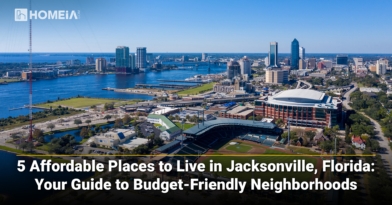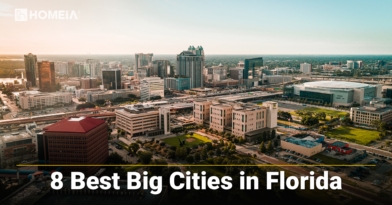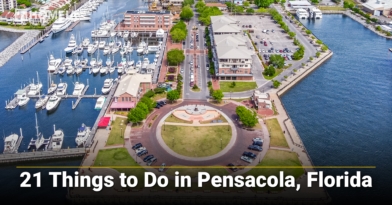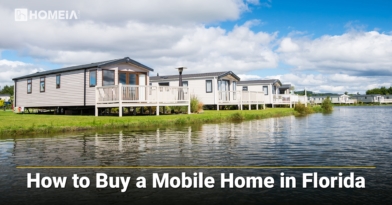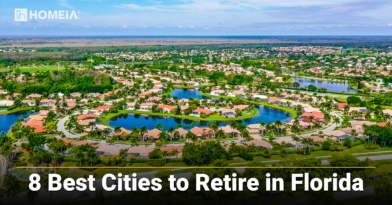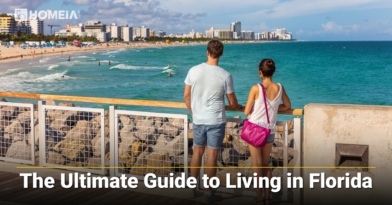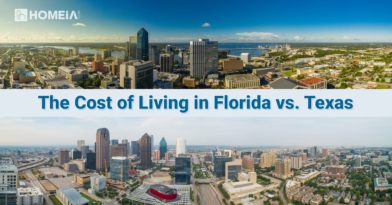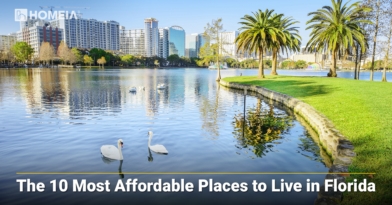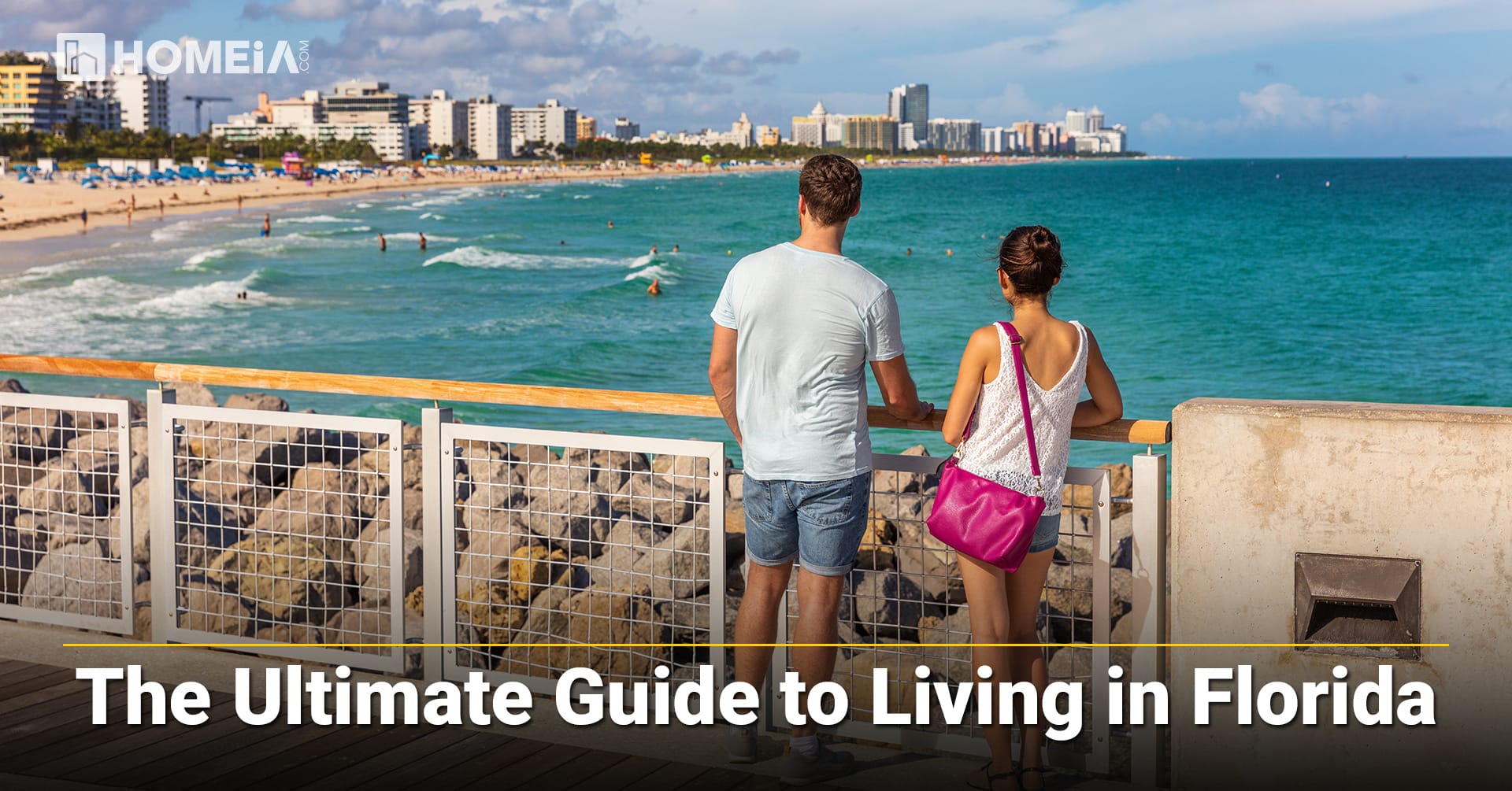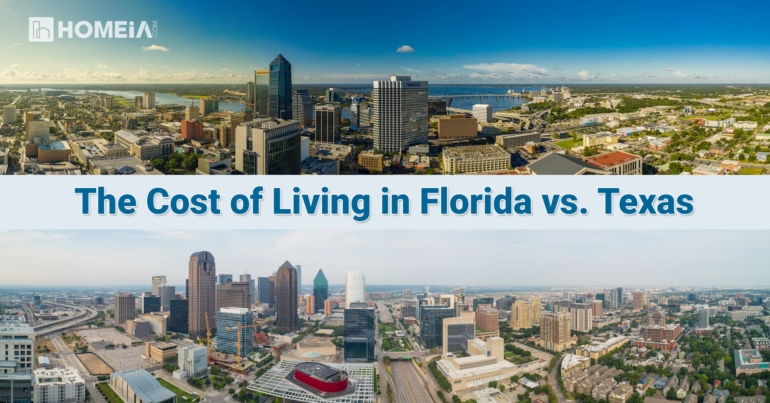10 Key Things to Know About Living in Florida. Embracing the Sunshine State
- Author:by Amber C. Lee Porrazzo
- Category: City Living Guide
Welcome to Florida, a state renowned not only for its abundant sunshine and pristine beaches but also for its unique blend of cultures, its diverse ecosystems and its dynamic lifestyle. Often referred to as the Sunshine State, Florida offers a distinctive living experience that combines the allure of a tropical paradise with the amenities of a rapidly growing region.
Whether you’re considering a move to this vibrant state, planning a visit or simply curious about what life is like in this southeastern gem, understanding the multifaceted aspects of Florida is essential.
From the balmy, brightly colored streets of Miami to the tranquil shores of the Gulf Coast, from the bustling theme parks in Orlando to the serene natural beauty of the Everglades, Florida is a state of contrasts and surprises. It’s a place where one can bask in the endless summer climate, engage with a symphony of cultures and navigate the unique challenges and opportunities that it has to offer.
In this comprehensive guide, we delve into 10 key aspects of living in Florida. These include the state’s climate, its diverse natural and cultural landscapes, economic considerations (like the lack of state income tax), the reality of hurricanes and weather-related concerns, and the particularities of its real estate market. We also explore the outdoor lifestyle that Florida’s climate enables, the richness of its wildlife, the challenges of transportation and traffic, and much more.
So, let’s embark on this journey to uncover the joys, challenges and unique experiences that define life in Florida.
The 8 Best Places to Live in Florida for Young Professionals
We have listed the cities below from lowest to highest cost of living. As described at the outset, the rankings and scores are based on a larger set of characteristics that we have reviewed…
Table of Contents:
- 1. Year-Round Sunshine and (Lots of) Warmth
- 2. Beach Paradise and Natural Splendors
- 3. The Pulse of Tourism
- 4. A Financially Friendly State
- 5. Bracing for Hurricanes
- 6. A Vibrant Mix of Cultures
- 7. Real Estate: Beachfront to Suburban
- 8. The Outdoors Awaits
- 9. Coexisting with Wildlife
- 10. Navigating Traffic and Transportation
I. Regional Differences: North vs. South and East vs. West
As with any state, there are regional differences that make up the cultural tapestry and community feeling of the different areas of Florida.
The Sunshine State is over 400 miles long and extends through two time zones. Differences can be observed between North Florida and South Florida, and also between the east and west coasts, due to climate and history. Additionally, each of Florida’s 67 counties have their own economic and development priorities, which give color to each county and city.
Let’s explore some of the larger differences within the state.
1. North Florida vs. South Florida
- A. Culture: North Florida, encompassing cities like Jacksonville and Tallahassee, tends to have a more “Southern” culture, reminiscent of neighboring states like Georgia.
- B. Climate: The climate in North Florida is slightly cooler compared to the tropical warmth of South Florida, which includes Miami and the Florida Keys.
- C. Demographics: South Florida is known for its diverse population, with strong Latin American and Caribbean influences, while North Florida has a more homogeneous demographic.
- D. Economy: South Florida is a hub for international trade and tourism, whereas North Florida’s economy is more diverse, including sectors like agriculture, military bases and education.
Recommended for you
2. East Coast vs. West Coast
- A. Beaches: Florida’s east coast is known for its Atlantic beaches, while the west coast offers family-friendly Gulf Coast beaches.
- B. Lifestyle: The east coast, featuring cities like Miami, Fort Lauderdale and Daytona Beach, is known for its bustling nightlife and vibrant urban centers. The West Coast, with places like Tampa, Naples, and Sarasota, is generally more family-friendly.
- C. Setting: The east coast is characterized by its lively beach culture. The west coast is cherished for its serene beaches, spectacular sunsets and proximity to natural reserves like the Everglades.
- D. Activities: The Atlantic coast’s proximity to the Bahamas and the Caribbean make it popular for cruises and water sports, while the Gulf coast appeals to nature lovers and those seeking a quieter lifestyle.
Florida’s regions offer diverse experiences, from the culturally rich and tropical South Florida to the more traditionally Southern and temperate North Florida and from the vibrant, bustling east coast to the serene and picturesque west coast. Understanding these regional nuances can help you find the part of Florida that best suits your lifestyle and preferences.
5 Most Affordable Places to Call Home in Orlando
This comprehensive guide is more than just a list of affordable places; it’s a window into the soul of Orlando, showcasing how the city’s diversity, community initiatives, and evolving landscapes make it an ideal destination for those seeking affordability without sacrificing the joys of living in a dynamic urban environment…
II. The 10 Essentials You’ll Want to Consider
Whether you’re contemplating a move or simply curious about life in this southern U.S. state, here are the 10 essential points you’ll want to consider before making your move:
1. Year-Round Sunshine and (Lots of) Warmth
Florida’s climate is a major selling point for new residents and visitors alike. Characterized by long, warm summers and mild winters, it’s a haven for sun-seekers. However, Florida’s humidity can be intense, and summers are often laced by (sometimes daily) brief yet extremely heavy afternoon rainstorms.
The heat can easily lead to heat stroke if you’re not prepared, and in some cities the roads will flood with the afternoon storms, so you’ll have to plan your transportation carefully if you move to an area prone to flooding.
With the year-round good weather and frequent sunshine, Florida is often a haven for aviators and outdoor enthusiasts who can take advantage of the many days of sun. Being one of the southernmost U.S. states, Florida also enjoys longer days, especially during the summer, which means that you can plan your activities outside later in the day.
Florida isn’t called the “lightning capital of the world” for nothing, and you will definitely need to learn how to be safe around this outdoor hazard if you plan to become a resident.
Recommended for you
2. Beach Paradise and Natural Splendors
From the famed Miami Beach to the tranquil shores of the Gulf Coast, Florida’s beaches are a highlight. Beyond the coastlines, natural wonders like the Everglades offer unique ecosystems and wildlife experiences.
Each beach is different, and the sand texture actually changes from north to south — from a coarse, large-grained gray to a finer tan-colored sand as you move further south. Some communities have even shipped in sand. This is the case in Sarasota, where the beaches are made of extremely fine white-as-snow sand.
In all Florida beach communities, be aware that the sand dunes and the sea turtle nests on the beaches are protected, off-limits areas. Many places have created natural preserves to save these beach ecosystems and the animals that call them home.
3. The Pulse of Tourism
Home to world-renowned attractions like Disney World and Universal Studios, Florida is a tourist hotspot. This tourism brings economic benefits, but also crowds and seasonal fluctuations that can impact local lifestyles. Many residents find tourism to be beneficial, as it fuels the area with jobs.
Agritourism — visiting farms and participating in farm activities — is a big draw to the state. People also come to camp or go “glamping” (luxury camping) in pristine natural Florida environments, or to hunt some of the as-allowed-by-permit or invasive creatures that roam the state, such as alligators, wild hogs, turkeys, deer or even boa constrictors.
10 Most Affordable Places to Live in Florida: Discovering Florida’s Hidden Gems
Florida, known for its sunny beaches, vibrant culture and diverse communities, is a dream destination for many. But living in this paradise doesn’t have to break the bank. In this article, we’ll explore some of the most affordable places in Florida that offer a great quality of life without the hefty price tag…
4. A Financially Friendly State
One of Florida’s financial perks is the absence of a state income tax, making it an attractive destination for retirees and professionals alike.
5. Bracing for Hurricanes
Florida’s location makes it prone to hurricanes and tropical storms, particularly from June to November. Residents must be prepared for these weather events, which can impact everything from insurance costs to emergency planning.
Hurricanes bring many hazards, including power outages, flooding, tornadoes and high winds that can damage power lines and buildings. All residents are encouraged to build an emergency kit upon moving to the state, as directed by their local officials.
It’s important to note that some home locations require you to purchase flood insurance in addition to home insurance. Flood insurance is an added cost, and it can often be difficult to acquire, as some insurance companies will not underwrite policies in Florida. Make sure you do your research on home insurance and flood zones before you purchase any property.
15 Key Factors to Know Before Buying a House in Florida
Luckily, we have you covered! With a little bit of brainstorming and some time to go over your preferences and needs, the decision to buy a house located in Florida will be easy and stress-free…
6. A Vibrant Mix of Cultures
This key point is probably one of the most beautiful parts about living in Florida.
Florida’s population is diverse, with strong Hispanic and Latino influences, a significant retiree community and a blend of many other cultures, making it a dynamic and culturally rich place to live. There are several university communities scattered throughout the state, and the many transplants who have already moved here add richness to each community.
Let’s explore the richness of the Florida community in a bit more detail.
A. Hispanic and Latin American Influence
Florida is home to large Hispanic and Latin American populations, particularly in cities like Miami and Orlando. This influence is evident in the local cuisine, music, festivals and language, with the beautiful Spanish language being widely spoken.
Annual events like Miami’s Calle Ocho Music Festival and Orlando’s Florida Puerto Rican Parade and Festival showcase the Latin music, dance and culinary traditions of Florida’s residents, drawing large crowds and fostering a sense of community.
B. Retiree Population
The Sunshine State has long been a favored destination for retirees seeking warmth and a more easygoing pace of life from all over the U.S. and Canada. This has led to the development of numerous dedicated retirement communities, each with its own unique culture and lifestyle.
The retiree population has significantly influenced the local economy, healthcare services and recreational activities in many Florida locations, catering to the needs and preferences of senior residents.
5 Affordable Places to Live in Jacksonville, Florida: Your Guide to Budget-Friendly Neighborhoods
Like any major city, finding affordable living spaces can be challenging. This article takes a look at the most budget-friendly neighborhoods in Jacksonville, offering a blend of low living costs and quality life…
C. Caribbean Connections
Florida’s proximity to the Caribbean has resulted in substantial Caribbean communities, especially in South Florida. These communities bring a distinct cultural flavor to the state, seen in festivals, music and cuisine.
The Caribbean influence merges with other cultural elements in Florida, creating a vibrant, unique blend of traditions and lifestyles.
D. Diverse Religious and Ethnic Communities
Florida hosts a variety of religious communities, including Christian, Jewish, Muslim, Hindu and Buddhist congregations, among others. This diversity adds to the state’s cultural richness.
Cities like Miami and Tampa have neighborhoods known for specific ethnic communities, like Little Havana and Ybor City, that offer cultural experiences through food, art and history.E. Arts and Entertainment
Florida boasts a thriving arts scene with numerous theaters, museums and galleries. Events like Art Basel in Miami attract international attention.
The state’s music scene is diverse, featuring Latin, Caribbean, rock, hip-hop and country music. Florida is also home to several renowned performing arts centers and orchestras.
F. Food and Cuisine
Florida’s culinary scene reflects its cultural diversity, with an abundance of Latin, Caribbean, Southern and seafood-centric cuisines. From Cuban sandwiches to fresh seafood, the state offers a rich dining experience.
Florida’s cultural diversity is one of its greatest strengths, offering residents and visitors a chance to experience a world of traditions, cuisines, languages and arts within its borders.
The 9 Best Places to Live Florida for Families with Young Kids in 2024
We have listed these cities from lowest to highest cost of living. As described at the outset, the rankings and HOMEiA index scores are based on a larger set of characteristics that we have reviewed…
7. Real Estate: Beachfront to Suburban
The real estate landscape in Florida is as varied as its geography, offering everything from luxurious beachfront properties to affordable suburban homes. Prospective buyers should navigate this market carefully, considering high-impact factors such as proximity to the coast and possible hurricane risks.
Here’s a deeper dive into what prospective residents can expect:
A. Beachfront Properties
Properties along Florida’s extensive coastline are highly sought after, often commanding premium prices. Areas like Miami Beach, Naples and the Florida Keys are known for their upscale homes and condos with stunning ocean views.
Living by the beach comes with additional considerations, such as higher insurance costs, especially for hurricane and flood coverage. Maintenance can also be more demanding on both your home and your vehicle due to the salty air and humidity.
B. Suburban Neighborhoods
For those seeking more affordable options, Florida’s suburban areas offer a break from the high costs of beachfront living while still providing a lot of fun activities and city life. Suburbs surrounding the cities of Orlando, Tampa, Tallahassee and Jacksonville provide more space and a quieter environment, at usually a more affordable cost.
These suburban areas often boast strong community ties, decent schools and family-friendly amenities, such as parks and recreational centers, making these neighborhoods an ideal home for families and retirees.
The 8 Largest Cities in Florida
For each of these communities, we assign a HOMEiA Score, which provides an overall assessment – based on affordability, lifestyle, healthcare, education and other relevant factors – of the city’s appeal as a place to call home…
C. Urban Living
For those who prefer a more urban lifestyle, cities like Miami, Tampa and Orlando offer classy, often brand-new downtown living options. These areas are close to employment centers, cultural attractions and the lively Florida nightlife, like Ybor City in Tampa or Church Street Station in Orlando.
Living in the city can also mean dealing with issues like limited parking, higher crime rates in some areas and a generally faster-paced lifestyle. Transportation also tends to be congested in these urban areas.
D. The Impact of Climate Change
With the threat of rising sea levels, buyers in coastal areas are increasingly considering the long-term impacts of climate change on their properties. This has led to a growing interest in properties at higher elevations and in more climate-resilient areas. The entire center spine of the state is at least 140 feet higher than sea level, making the Florida inland an attractive home location for people seeking safer climate change options.
E. Buying vs. Renting
The decision to buy or rent in Florida largely depends on personal circumstances and the local real estate market, which can vary greatly between different cities. Some areas might offer more affordable renting options, while other places incentivize home buyers.
Florida’s real estate market caters to a wide range of preferences and budgets, from the allure of beachfront living to the comfort of suburban neighborhoods and the excitement of urban centers. Prospective buyers and renters should consider factors like location, lifestyle, budget and long-term climate risks when making their decision.
21 Exciting Things to Do in Pensacola, Florida
Pensacola is warm, sunny, beachy and full of activities and venues to keep you busy and entertained. Whether you prefer active adventures or long, relaxing days watching the waves roll in, you can find what you’re looking for in Pensacola, Florida.
8. The Outdoors Awaits
The state’s geography and climate are perfect for outdoor enthusiasts. Boating, fishing, golfing and kayaking are just a few activities that Floridians enjoy year-round.
Florida’s unique geography and climate make it a haven for outdoor activities, offering endless opportunities for residents and visitors alike to engage with nature and enjoy a variety of recreational pursuits.
A. Water Sports and Beach Activities
With over 1,350 miles of coastline, beach activities like swimming, sunbathing and beach volleyball are a way of life.Florida’s myriad of lakes, rivers and coastal waters make it ideal for boating and fishing enthusiasts. The state is known as the fishing capital of the world, with both freshwater and saltwater options.The Atlantic coast, particularly around areas like Cocoa Beach, is popular for surfing. Other water sports such as jet skiing, paddleboarding and kite surfing are also widely enjoyed.
B. Golfing
Florida’s flat terrain and year-round sunshine make it one of the best states for golf. Home to hundreds of golf courses, it caters to all skill levels and budgets.
C. Hiking, Biking and Wildlife Viewing
Florida’s state parks and trails offer beautiful settings for hiking, biking and wildlife viewing. The Everglades National Park, for example, is a unique ecosystem where one can spot alligators, manatees and a plethora of bird species.
Florida also has a 1,300-mile-long trail akin to the Appalachian Trail, called the Florida Trail, that offers hikers a chance to experience a variety of Florida’s natural landscapes, from beaches to swamps and forests. This trail extends all the way from the panhandle in the west down to the Keys in the south.
8 Key Steps to Buy Mobile Home in Florida
We’ll guide you in your research as you talk to other mobile homeowners in Florida: Think about how you’ll prioritize price and luxury, get to know the relevant laws, find places to shop, look into different manufacturers, and think about natural conditions in your area…
D. Camping and Adventure Sports
With its diverse natural environments, Florida is great for camping. Whether it’s beach camping or setting up in the midst of pine forests, there’s a spot for every kind of camper.
For the more adventurous, there are activities like zip-lining, rock climbing and even snorkeling in Florida’s crystal-clear springs.
E. Ecotourism and Conservation
Ecotourism is growing, with an emphasis on conserving natural habitats and enjoying nature responsibly. Eco-tours, such as kayaking trips in the mangroves or bird-watching tours, are popular.
In places like Crystal River, visitors have the unique opportunity to swim with manatees in their natural habitat, a testament to Florida’s commitment to wildlife conservation.
Florida’s outdoor lifestyle is a significant aspect of its appeal. Whether you’re a serious sports enthusiast, a nature lover or simply someone who enjoys being outside, Florida offers an array of activities that let you immerse yourself in the amazing great outdoors.
The 8 Best Places to Live in Florida For Retirees in 2024
We have presented options that will fit different budgets and needs – there should be a choice for everyone. We have listed the most affordable cities first, though the ranks and index scores are assigned based on a larger set of characteristics that we have reviewed…
9. Coexisting with Wildlife
Florida’s diverse ecosystems include alligators, a variety of bird species and marine life. Living here means respecting and coexisting with these native inhabitants. Many species are protected, which means that you’re not allowed to disturb their nests or interfere with their behavior on your property.
A. Alligators and Crocodiles
There’s a Florida saying that if you see a body of water, there’s at least one alligator living in it!
Alligators and, to a lesser extent, crocodiles are a common sight in Florida’s waterways. While they are fascinating to observe, it’s crucial to maintain a safe distance and never feed them. Proper fencing around bodies of water and awareness of their presence, especially during their mating season in the spring, are essential for safety.
B. Marine Life
Florida’s waters are filled with amazing marine life, including dolphins, manatees, sea turtles and a variety of fish species. The state’s numerous beaches and coastal areas offer opportunities for sightings and interactions.
Protection of marine habitats is a significant focus, with initiatives to preserve coral reefs, seagrass beds and sea turtle nesting sites.
C. Birds
Florida is a prime location for birdwatching, home to a vast array of both native and migratory birds, including herons, egrets, pelicans and the iconic Florida scrub jay. Conservation areas and bird sanctuaries across the state play a vital role in protecting these avian habitats.
Pros and Cons of Living in Florida
If you’ve decided to make Florida your new home, you’re in luck – it’s a big and varied place, with something for all ages, family dynamics and budget. Continue reading as we dive into some notable Pros and Cons about the state itself, the top cities to live in across a variety of categories, and…
D. Insects and Reptiles
Due to its humid climate, Florida has a significant population of mosquitoes and other insects. Residents often take precautions like using insect repellent and maintaining proper screening in homes. Snakes, lizards and other reptiles are common. While most are harmless, it’s important to be aware of and respect wildlife, keeping a safe distance from potentially dangerous species.
E. Endangered Species
Florida is home to several endangered species, such as the Florida panther and the manatee. Efforts by wildlife conservation organizations and state agencies aim to protect these species and their habitats.
F. Living in Harmony with Nature
Learning about the local wildlife and animal habitats helps to encourage a harmonious coexistence. Participating in local conservation efforts and respecting wildlife regulations are ways residents can contribute to the well-being of Florida’s diverse fauna.
Coexisting with Florida’s wildlife is an integral part of the state’s allure. It offers a unique opportunity to live amid a rich and varied natural world, but it also requires a commitment to understanding, respecting and protecting the natural inhabitants of its vibrant ecosystems.
The Cost of Living in Florida vs. Texas
Texas and Florida are vast and have hundreds of communities to choose from. But what are the pros and cons of living in each state? Come with HOMEiA as we explore 7 crucial factors that reveal the true costs of choosing Florida or Texas as your new home…
Transportation varies across the state. While public transit is available in larger cities, owning a car is often necessary, especially in suburban or rural areas. Traffic in tourist-heavy and urban areas can be challenging.
For example, most days in the Miami area, the eight-lane highways experience heavy traffic that is often compared to the headache of LA traffic. Other communities have two-lane state highways that move freely. Some communities are golf cart havens where speeds are set low for all vehicles and parking prioritizes small carts over cars.
In popular areas like Miami, Orlando and Tampa, traffic can be heavy, particularly during rush hour and during tourist season. Planning for additional travel time is often necessary. The influx of tourists, especially in areas close to major attractions or during events, can significantly impact traffic flow.
Public transportation options vary greatly across the state. Large cities like Miami have more developed systems, including the Metrorail and buses, while in other areas options may be limited. In Central Florida, the SunRail commuter train connects several cities and towns, offering an alternative to driving.
Florida’s major roads and highways are generally well maintained; however, ongoing construction projects can cause delays. The state has a number of toll roads. Visitors and new residents should consider getting a SunPass for convenience and savings on tolls.
10 Most Affordable Places to Live in Florida in 2024
With year-round warm weather and over 8,000 miles of coastline, it’s no wonder Florida is a prime vacation destination. Filled with wildlife, beaches, lakes, rivers, amusement parks, diverse entertainment options and much more, the population of Florida is growing with people that want to call Florida “home,” soak up the sun…
In many Florida cities, cycling is a viable mode of transportation, supported by bike lanes and trails. Many old railway tracks have been converted into nice bike paths that stretch through and connect cities. However, cyclists should be cautious and aware of the local traffic laws.
While Florida’s weather is conducive to walking, pedestrian safety is a concern, especially in high-traffic areas. Some cities are more walkable than others, with dedicated pedestrian areas.
Florida’s laws require drivers to have car insurance that includes uninsured motorist coverage. New residents need to register their vehicles within a specific timeframe. Understanding evacuation routes and having a plan during hurricane season is crucial for those living in or visiting coastal areas.
Florida is served by several major airports, including Miami International Airport and Orlando International Airport, offering both domestic and international flights. The state’s location makes road trips to neighboring states an easy option for long-distance travel within the U.S.
Navigating Florida’s transportation landscape requires a mix of planning, understanding local patterns, and being open to various modes of transport. Whether you’re commuting, exploring the state, or traveling to and from Florida, being informed about the available options and prepared for potential challenges will ensure a smoother experience.
The 9 Cheapest and Safest Places to Live in Florida in 2024
Get ready to explore some of Florida’s safest small communities for the affluents. From coastal towns to pleasant inland locations, there will surely be something for everyone who can afford the lifestyle…
Conclusion
Florida offers a unique blend of natural beauty, cultural diversity and recreational opportunities, all under the banner of warm, sunny skies. However, it’s important to consider aspects like weather risks and the impact of tourism. If you’re adaptable and ready for a little adventure, Florida could be your paradise!
Moving to or visiting Florida soon? Share your thoughts and experiences in the comments below or send the author a message directly through the contact form!












